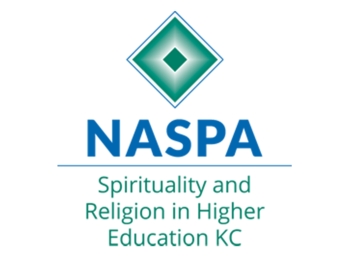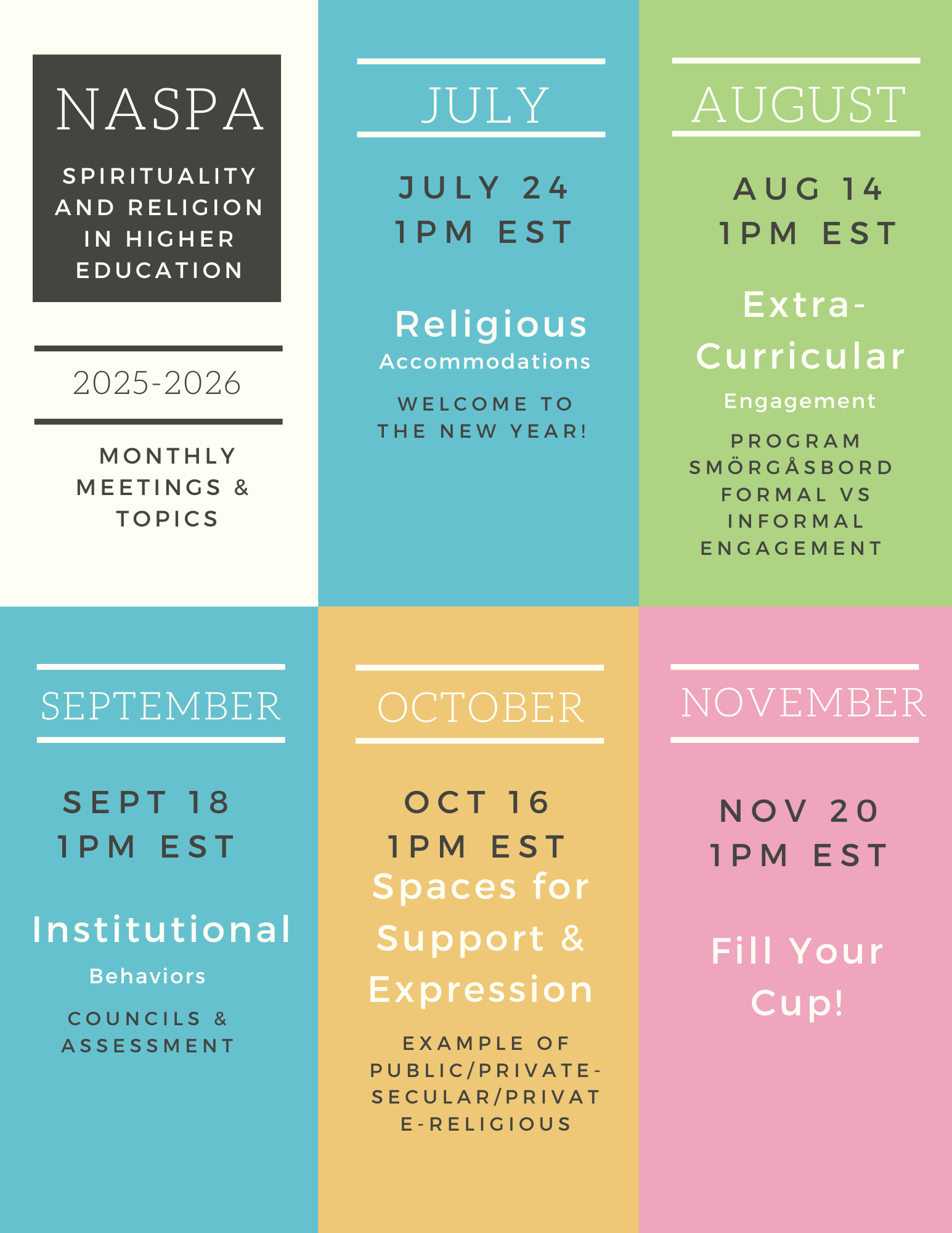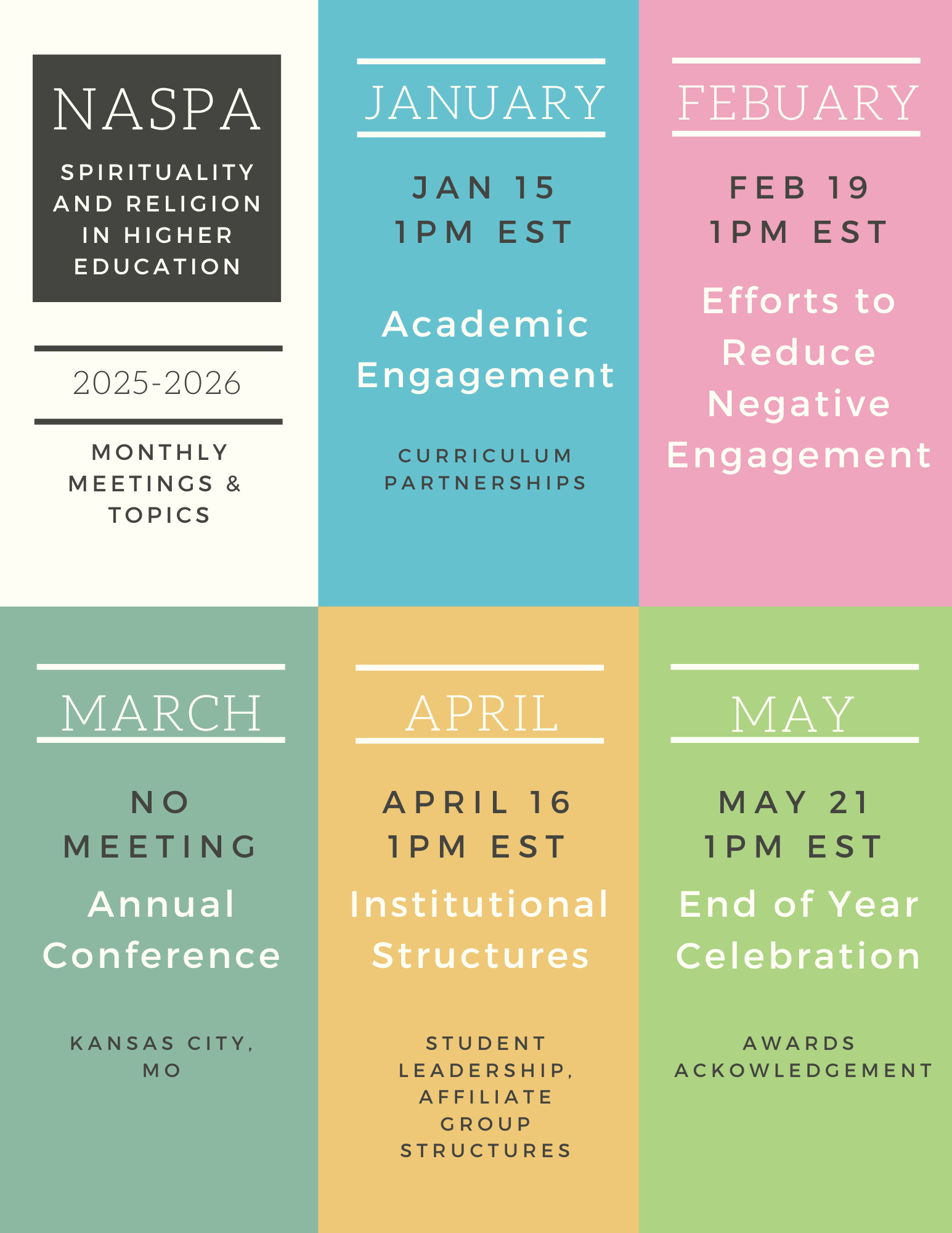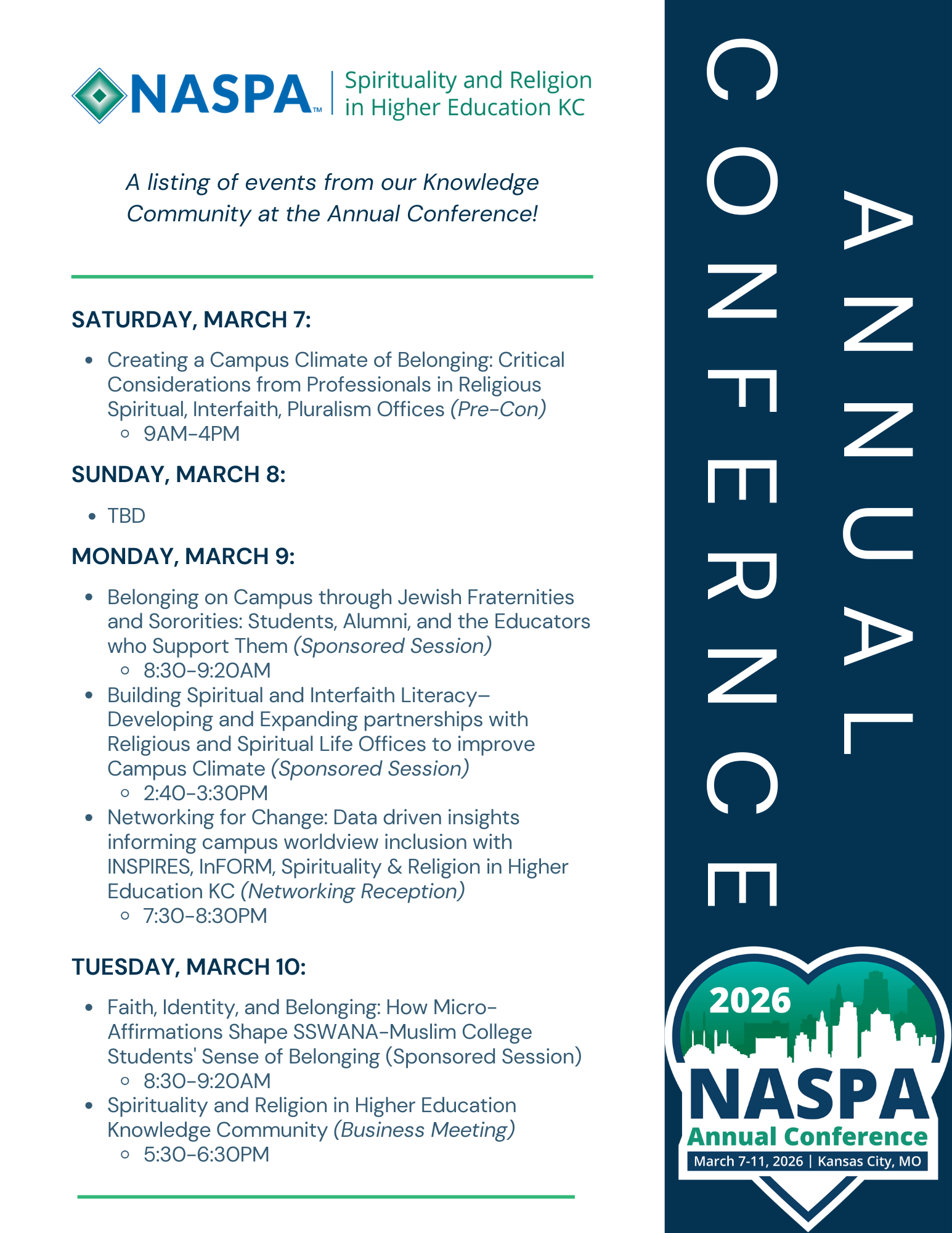
Spirituality and Religion in Higher Education Knowledge Community
Equity, Inclusion and Social Justice Equity, Inclusion, and Social Justice Division Spirituality and Religion in Higher Education
The Spirituality and Religion in Higher Education Knowledge Community builds community, enhances knowledge of, and advocates for diverse religious, secular, and spiritual worldviews.
Our current themes are:
-
Community - To create spaces for connection for professionals to engage around worldview difference
-
Education - To enhance knowledge and awareness around religious, secular, and spiritual worldviews by informing the membership about relevant research and practices
-
Advocacy - To highlight practices and strategies that enhance equity for all worldviews
Click the "Join Community" button below to become a KC member in Volunteer Central!
Home
Welcome to the Spirituality and Religion in Higher Education KC! We work to support and network student affairs and religious life professionals, students, faculty, chaplains, and others who are interested in conversations, research, and best practices for worldview diversity in higher education. We look forward to your engagement. Please let us know how we can best support you in this work.
Complete Your Profile
Login and update your profile.
About
MISSION
The Spirituality and Religion in Higher Education Knowledge Community builds community, extends knowledge of, and advocates for justice on behalf of diverse religious, secular, and spiritual worldviews.
VISION
Our vision is to enhance equitable practices for worldviews in higher education and to facilitate members' support for student's religious, secular, and spiritual development.
VALUES
The Spirituality and Religion in Higher Education Knowledge Community adheres to NASPA’s Guiding Principles of integrity, innovation, inclusion, and inquiry.
Leadership Team
Knowledge Community leaders are NASPA volunteers who generously devote their time to the KC for a service period of two years, planning events, activities, and programming related to the Annual Conference. Chairs are elected by Knowledge Community members while Regional Representatives and other roles are by appointment. View vacancies in the "Get Involved!" section and contact the current Chair to express interest.
Monthly Gatherings and Events
Most KC meetings are open meetings. These Monthly Gatherings currently take place at 1:00pm ET on Third Thursdays during the academic year, however please look for any amendments to the usual dates in the below image of upcoming gatherings. Join the KC on Volunteer Central to be added to our list to receive meeting notices, updates, and links.
Additionally, at various times, the NASPA Central Office or other NASPA Constituent Group will host the NASPA Annual Conference Knowledge Communities Fair, as well as co-hosted workshops and webinars with other KCs and organizations. Please be on the lookout for these oppportunities in your NASPA emails.


Annual Conference
The KC Leadership Team and membership is involved during each NASPA Annual Conference, wherein NASPA members are encouraged to submit conference session proposals annually in August and designate them for consideration as KC-sponsored sessions, including those of a spiritual and/or religious nature that can be affiliated with our community. Additionally, the KC attempts to sponsor either a local site visit or reception that would prove beneficial the to the KC members, as well as others interested in interfaith relations and dialogue.
Please see the upcoming events for the 2025 Annual Conference below!

Resources
The below resources are broken down by the seven domains present within the INSPIRES Campus Climate Index. Presentations and selected readings will become available as our distinguished guests present upon said domains at our abovementioned Monthly Gatherings.
RELIGIOUS ACCOMMODATIONS
-
More information coming soon!
EXTRA-CURRICULAR ENGAGEMENT
Presentations
-
Cirillo, Andrew. (2025, August 14). Extra-curricular Engagement. [Presentation]. National Association of Student Personnel Administrators Spirituality and Religion in Higher Education Knowledge Community August Monthly Gathering, Virtual. Link.
Selected Readings
-
Mayhew, M. J., & Rockenbach, A. N. (2021). Interfaith Learning and Development. Journal of College and Character, 22(1), 1-12. https://doi.org/10.1080/2194587X.2020.1860778
-
Rockenbach, A. N., Mayhew, M. J., Giess, M. E., Morin, S. M., Staples, B. A., Correia-Harker, B. P., & Associates. (2020). IDEALS: Bridging religious divides through higher education. Interfaith Youth Core.
-
Snipes, J. T., & Manson, S. (Eds.). (2020). Remixed and Reimagined: Innovations in Religion, Spirituality, and (Inter)faith in Higher Education (Ser. Culture and Society in Higher Education). Myers Education Press, LLC.
INSTITUTIONAL BEHAVIOR
Presentations
-
Gill-Morris, Anisha. (2025, September 18). NASPA KC: Campus Protests Lessons from the Israel-Hamas Conflict [Presentation]. National Association of Student Personnel Administrators Spirituality and Religion in Higher Education Knowledge Community September Monthly Gathering, Virtual. Link.
SPACE FOR SUPPORT AND EXPRESSION
Selected Readings
-
Crompton, A. (2013). The architecture of multifaith spaces: God leaves the building. Journal of Architecture (London, England), 18(4), 474-496. https://doi.org/10.1080/13602365.2013.821149
-
Johnson, K., & Laurence, P. (2012). Multi-faith Religious Spaces on College and University Campuses. Religion & Education, 39(1), 48-63. https://doi.org/10.1080/15507394.2012.648579
ACADEMIC ENGAGEMENT
-
More information coming soon!
EFFORTS TO REDUCE NEGATIVE BEHAVIOR
-
More information coming soon!
INSTITUTIONAL STRUCTURES
-
More information coming soon!
Awards
The Spirituality and Religion in Higher Education KC presents annual awards to recognize exemplary work at or near the time of the NASPA Annual Conference. Nominations open in late August and close early October. Contact the Awards Coordinator for more information.
Support Us
Would you like to help support our continuing ability to provide cutting-edge research in the field of spiritual and religious iniatives within the realm of student affairs in higher education? If so, we are extremely grateful, as you allow the Leadership Team to advocate for those who find this work significant and impactful upon our faculty, staff, and students across our university communities. Your gift helps to provide the Spirituality and Religion in Higher Education Knowledge Community with opportunities to recognize people and institutions, research, and thought collective resources that transform how our constituents embrace the world of spirituality and interfaith iniatives in a healthy, positive, and dialogue-directive manner.
Thank you for your support! Click the link below to support the SRHE KC today (and don't forget to select KC - Spirituality and Religion in Higher Education* on the "Gift Designation" dropdown).
Helpful Links and Related Organizations
Please see the below surrounding various interfaith, secular, religious, and pluralism-based resources and partner institutions.
Initiatives
- Aspen Institute Religion & Society Program
The Religion & Society Program ignites change through convening, catalyzing, and researching the challenges and opportunities at the convergence of religion, culture, and justice. - Association of Religion Data Archives
Quality Data on Religion, providing free access since 1998. - Character Clearinghouse
An online center for research, curricula, and student affairs resources relating to moral development of college students. - Education as Transformation
An international organization that works with colleges, universities, K-12 schools and related institutions exploring the impact of religious diversity on education and strategies for addressing this diversity, and the role of spirituality in educational institutions, and particularly its relationship to teaching and learning pedagogy; the cultivation of values; moral and ethical development; and the fostering of global learning communities and responsible global citizens. - Harvard Religion and Public Life
Religion and Public Life promotes the public understanding of religion in service of a just world at peace. - INSPIRES Campus Climate Index
The Interfaith Spiritual, Religious, and Secular Campus Climate Index is a campus climate benchmarking tool for campuses and a college planning tool for students and families. - Interfaith Research
Publicly available research archive from joint projects of OSU and NC State Universities under PIs Drs. Matthew Mayhew and Alyssa Rockenbach. - Journal of College and Character
"A professional journal that examines how colleges and universities influence the moral and civic learning and behavior of students." - The Pluralism Project
An initiative of Harvard University that seeks to bring education and understanding to the vastness that is the pluralistic landscape. - Spirituality in Higher Education
A National Study of College Students' Search for Meaning and Purpose.
Partner Organizations
- Association for Chaplaincy and Spiritual Life in Higher Education (ACSLHE)
A community of college and university chaplains sharing best practices, resources, and holding time for sacred space and dialogue with one another. - American College Personnel Association (ACPA) Commission for Spirituality, Faith, Religion, & Meaning (CSFRM)
The ACPA's equivalent to our Knowledge Community, offering education, events, and resources within the larger student affairs milieu. - Interfaith America
Interfaith America inspires, equips, and connects leaders and institutions to unlock the potential of America’s religious diversity. - North American Interfaith Network (NAIN)
Network of interfaith organizations and initiatives in the North American context. - Religion & Education Collaborative
An interdisciplinary network of educators, students, and scholars who examine issues involving religion and education in the United States, Canada, and around the globe. - Wabash Center for Teaching and Learning in Theology and Religion
The Wabash Center for Teaching and Learning in Theology and Religion seeks to enhance and strengthen education in theology and religion in theological schools, colleges, and universities in the United States and Canada.




